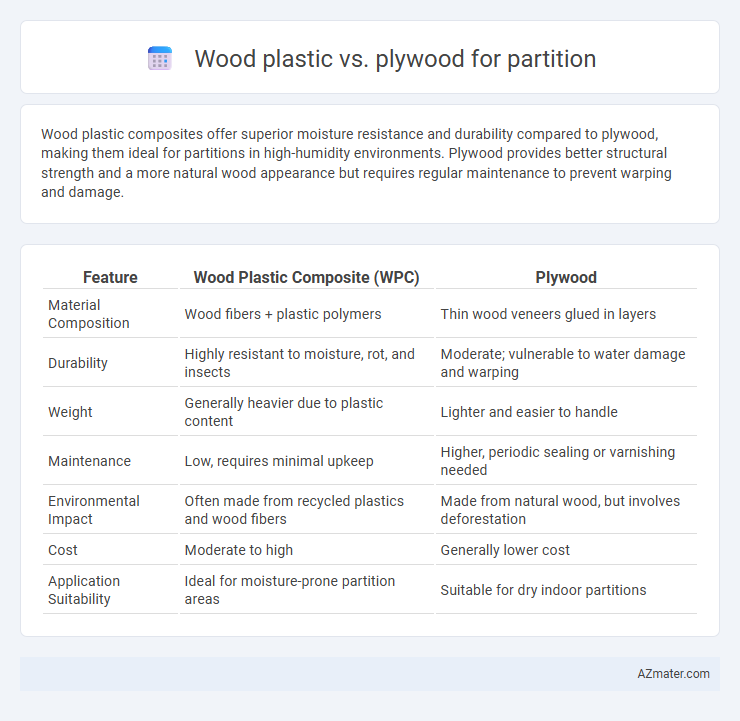Wood plastic composites offer superior moisture resistance and durability compared to plywood, making them ideal for partitions in high-humidity environments. Plywood provides better structural strength and a more natural wood appearance but requires regular maintenance to prevent warping and damage.
Table of Comparison
| Feature | Wood Plastic Composite (WPC) | Plywood |
|---|---|---|
| Material Composition | Wood fibers + plastic polymers | Thin wood veneers glued in layers |
| Durability | Highly resistant to moisture, rot, and insects | Moderate; vulnerable to water damage and warping |
| Weight | Generally heavier due to plastic content | Lighter and easier to handle |
| Maintenance | Low, requires minimal upkeep | Higher, periodic sealing or varnishing needed |
| Environmental Impact | Often made from recycled plastics and wood fibers | Made from natural wood, but involves deforestation |
| Cost | Moderate to high | Generally lower cost |
| Application Suitability | Ideal for moisture-prone partition areas | Suitable for dry indoor partitions |
Introduction to Partition Materials
Wood plastic composites (WPC) and plywood are popular partition materials known for their durability and aesthetic appeal. WPC combines wood fibers with thermoplastic polymers, offering resistance to moisture, termites, and warping, making it ideal for humid environments. Plywood, constructed from multiple wood veneers bonded together, provides strength, flexibility, and a natural wood finish, often preferred for traditional or high-end partitions.
Overview of Wood Plastic Composite
Wood plastic composite (WPC) is a durable, low-maintenance material made from a blend of wood fibers and thermoplastics, offering superior resistance to moisture, pests, and rot compared to traditional plywood. This composite is highly versatile for partitions, providing enhanced dimensional stability and reduced warping, which is crucial in environments prone to humidity and temperature changes. WPC's eco-friendly composition and longer lifespan make it a cost-effective alternative to plywood, especially for applications requiring longevity and minimal upkeep.
Understanding Plywood for Partitions
Plywood, composed of multiple thin veneer layers bonded with adhesive, offers superior strength and stability for partitions compared to wood plastic, which is a composite of plastic and wood fibers. Its high load-bearing capacity and resistance to warping make plywood ideal for structural partition walls in both residential and commercial settings. With excellent nail-holding ability and smooth surface finish, plywood supports various finishes and ensures long-lasting durability in partition applications.
Durability: Wood Plastic vs. Plywood
Wood plastic composites (WPC) exhibit superior durability compared to plywood for partitions due to their resistance to moisture, rot, and insect damage, ensuring longevity in humid or outdoor environments. Plywood, while strong and versatile, is more prone to warping, delaminating, and decay when exposed to water or fluctuating humidity levels. Choosing WPC partitions enhances structural integrity and reduces maintenance costs over time in demanding conditions.
Moisture and Termite Resistance
Wood plastic composites (WPC) offer superior moisture resistance compared to plywood, making them ideal for partitions in humid or wet environments. Termite resistance is significantly higher in wood plastic materials due to the synthetic polymers that deter insect infestation, unlike plywood which is highly susceptible to termite damage. Choosing WPC enhances durability and reduces maintenance costs in moisture-prone and termite-active areas.
Installation Process and Ease
Wood plastic composite (WPC) panels offer a streamlined installation process due to their lightweight nature and interlocking designs, making them ideal for partitions requiring quick assembly. Plywood, while sturdy and durable, demands more precision during installation, often involving cutting, fastening, and finishing that increase labor time. The ease of handling WPC reduces installation complexity and time, whereas plywood's rigid structure may require professional tools and skills for optimal partition setup.
Aesthetic Appeal and Finishing Options
Wood plastic composites offer a modern, uniform appearance with smooth finishes that resist moisture and fading, making them suitable for contemporary partition designs. Plywood provides a natural wood grain texture that enhances aesthetic appeal with warm, organic tones and can be customized through staining, painting, or laminating for versatile finishing options. Both materials support various design styles, but plywood allows for more traditional and rustic looks, while wood plastic emphasizes durability and low maintenance in finishing.
Environmental Impact and Sustainability
Wood plastic composite (WPC) partitions offer a significant environmental advantage over plywood due to their use of recycled plastics combined with wood fibers, reducing landfill waste and conserving natural forests. Plywood production typically involves cutting down mature trees, contributing to deforestation and higher carbon footprints, while WPC manufacturing uses sustainable materials and emits fewer greenhouse gases. Choosing WPC for partitions supports circular economy practices by extending the life cycle of post-consumer plastics and promoting responsible resource management.
Cost Comparison and Long-Term Value
Wood plastic composite (WPC) panels typically have a higher upfront cost compared to plywood for partitions, due to their durability and resistance to moisture and termites. Plywood is more affordable initially but may incur higher maintenance and replacement expenses over time because of its susceptibility to warping and damage. Considering long-term value, WPC offers better cost-efficiency with lower maintenance and longer lifespan, especially in humid or high-traffic environments.
Best Use Cases and Final Recommendations
Wood plastic composite (WPC) offers superior moisture resistance and durability, making it ideal for partitions in high-humidity or outdoor environments such as bathrooms and balconies. Plywood excels in applications requiring a natural wood aesthetic and structural strength, suitable for indoor partitions in offices and living rooms where weight and easy installation are priorities. For best use, choose WPC for long-lasting, low-maintenance separators exposed to moisture, while plywood remains the preferred choice for cost-effective, visually appealing interior partitions.

Infographic: Wood plastic vs Plywood for Partition
 azmater.com
azmater.com